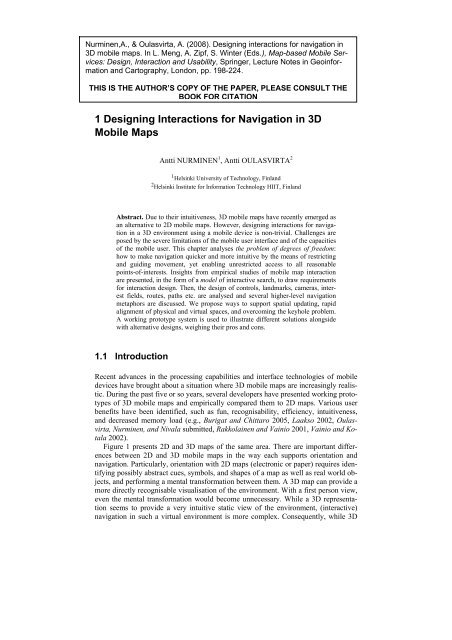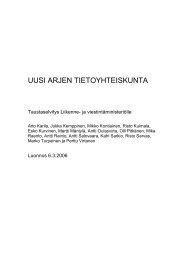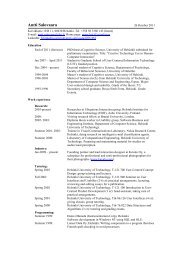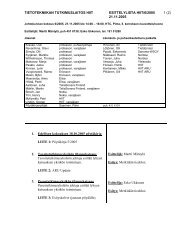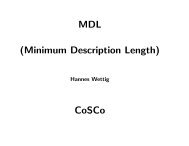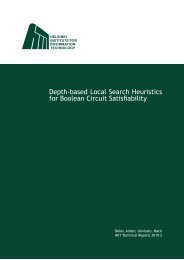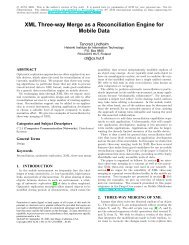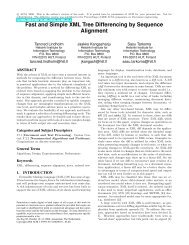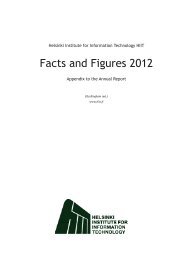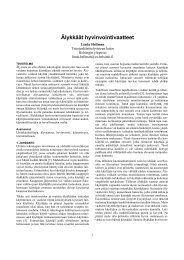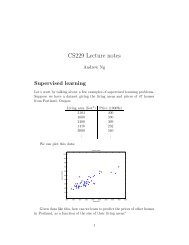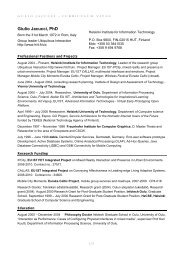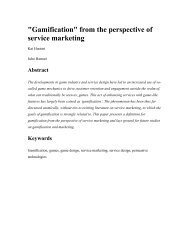1 Designing Interactions for Navigation in 3D Mobile Maps
1 Designing Interactions for Navigation in 3D Mobile Maps
1 Designing Interactions for Navigation in 3D Mobile Maps
You also want an ePaper? Increase the reach of your titles
YUMPU automatically turns print PDFs into web optimized ePapers that Google loves.
Nurm<strong>in</strong>en,A., & Oulasvirta, A. (2008). <strong>Design<strong>in</strong>g</strong> <strong>in</strong>teractions <strong>for</strong> navigation <strong>in</strong><br />
<strong>3D</strong> mobile maps. In L. Meng, A. Zipf, S. W<strong>in</strong>ter (Eds.), Map-based <strong>Mobile</strong> Services:<br />
Design, Interaction and Usability, Spr<strong>in</strong>ger, Lecture Notes <strong>in</strong> Geo<strong>in</strong><strong>for</strong>mation<br />
and Cartography, London, pp. 198-224.<br />
THIS IS THE AUTHOR’S COPY OF THE PAPER, PLEASE CONSULT THE<br />
BOOK FOR CITATION<br />
1 <strong>Design<strong>in</strong>g</strong> <strong>Interactions</strong> <strong>for</strong> <strong>Navigation</strong> <strong>in</strong> <strong>3D</strong><br />
<strong>Mobile</strong> <strong>Maps</strong><br />
Antti NURMINEN 1 , Antti OULASVIRTA 2<br />
1 Hels<strong>in</strong>ki University of Technology, F<strong>in</strong>land<br />
2 Hels<strong>in</strong>ki Institute <strong>for</strong> In<strong>for</strong>mation Technology HIIT, F<strong>in</strong>land<br />
Abstract. Due to their <strong>in</strong>tuitiveness, <strong>3D</strong> mobile maps have recently emerged as<br />
an alternative to 2D mobile maps. However, design<strong>in</strong>g <strong>in</strong>teractions <strong>for</strong> navigation<br />
<strong>in</strong> a <strong>3D</strong> environment us<strong>in</strong>g a mobile device is non-trivial. Challenges are<br />
posed by the severe limitations of the mobile user <strong>in</strong>terface and of the capacities<br />
of the mobile user. This chapter analyses the problem of degrees of freedom:<br />
how to make navigation quicker and more <strong>in</strong>tuitive by the means of restrict<strong>in</strong>g<br />
and guid<strong>in</strong>g movement, yet enabl<strong>in</strong>g unrestricted access to all reasonable<br />
po<strong>in</strong>ts-of-<strong>in</strong>terests. Insights from empirical studies of mobile map <strong>in</strong>teraction<br />
are presented, <strong>in</strong> the <strong>for</strong>m of a model of <strong>in</strong>teractive search, to draw requirements<br />
<strong>for</strong> <strong>in</strong>teraction design. Then, the design of controls, landmarks, cameras, <strong>in</strong>terest<br />
fields, routes, paths etc. are analysed and several higher-level navigation<br />
metaphors are discussed. We propose ways to support spatial updat<strong>in</strong>g, rapid<br />
alignment of physical and virtual spaces, and overcom<strong>in</strong>g the keyhole problem.<br />
A work<strong>in</strong>g prototype system is used to illustrate different solutions alongside<br />
with alternative designs, weigh<strong>in</strong>g their pros and cons.<br />
1.1 Introduction<br />
Recent advances <strong>in</strong> the process<strong>in</strong>g capabilities and <strong>in</strong>terface technologies of mobile<br />
devices have brought about a situation where <strong>3D</strong> mobile maps are <strong>in</strong>creas<strong>in</strong>gly realistic.<br />
Dur<strong>in</strong>g the past five or so years, several developers have presented work<strong>in</strong>g prototypes<br />
of <strong>3D</strong> mobile maps and empirically compared them to 2D maps. Various user<br />
benefits have been identified, such as fun, recognisability, efficiency, <strong>in</strong>tuitiveness,<br />
and decreased memory load (e.g., Burigat and Chittaro 2005, Laakso 2002, Oulasvirta,<br />
Nurm<strong>in</strong>en, and Nivala submitted, Rakkola<strong>in</strong>en and Va<strong>in</strong>io 2001, Va<strong>in</strong>io and Kotala<br />
2002).<br />
Figure 1 presents 2D and <strong>3D</strong> maps of the same area. There are important differences<br />
between 2D and <strong>3D</strong> mobile maps <strong>in</strong> the way each supports orientation and<br />
navigation. Particularly, orientation with 2D maps (electronic or paper) requires identify<strong>in</strong>g<br />
possibly abstract cues, symbols, and shapes of a map as well as real world objects,<br />
and per<strong>for</strong>m<strong>in</strong>g a mental trans<strong>for</strong>mation between them. A <strong>3D</strong> map can provide a<br />
more directly recognisable visualisation of the environment. With a first person view,<br />
even the mental trans<strong>for</strong>mation would become unnecessary. While a <strong>3D</strong> representation<br />
seems to provide a very <strong>in</strong>tuitive static view of the environment, (<strong>in</strong>teractive)<br />
navigation <strong>in</strong> such a virtual environment is more complex. Consequently, while <strong>3D</strong>
visualisations appear as an appeal<strong>in</strong>g option <strong>for</strong> designers, a major problem lies with<strong>in</strong><br />
the mean<strong>in</strong>gful and efficient control over such visualisations.<br />
Furthermore, there are non-trivial design problems aris<strong>in</strong>g from the characteristics<br />
of mobile human-computer <strong>in</strong>teraction (HCI). The key challenge <strong>in</strong> design is the<br />
problem of degrees of freedom (DOFs): how to balance freedom of movement with<br />
efficiency of navigation. The number of DOFs needed to completely control a <strong>3D</strong><br />
view exceeds the amount of <strong>in</strong>put controls <strong>in</strong> mobile devices, and the problem is accentuated<br />
by the fact that mobile devices have small displays, which implies that<br />
more motion is needed to gather the same amount of <strong>in</strong><strong>for</strong>mation. Moreover, as mobile<br />
users’ capability to <strong>in</strong>vest un<strong>in</strong>terrupted attention <strong>in</strong> a mobile device is known to<br />
be compromised (Oulasvirta et al. 2005), the <strong>in</strong>terface should allow them to display<br />
what ever is currently needed as quickly and easily as possible, without complicated<br />
manoeuvr<strong>in</strong>g that requires all of the user’s attention.<br />
This book chapter summarises three years of research and development ef<strong>for</strong>ts on<br />
m-LOMA, a <strong>3D</strong> mobile map of an urban environment (the city centre of Hels<strong>in</strong>ki)<br />
(Nurm<strong>in</strong>en 2006). Our goal has been to create an efficient <strong>in</strong>terface <strong>for</strong> navigat<strong>in</strong>g <strong>in</strong> a<br />
<strong>3D</strong> view with the limited resources available. We first review general goals <strong>for</strong> design<strong>in</strong>g<br />
a <strong>3D</strong> navigation <strong>in</strong>terface specifically <strong>for</strong> mobile devices. A model of user <strong>in</strong>teraction<br />
with <strong>3D</strong> maps is then presented. Subsequently, we <strong>for</strong>malise the problem of<br />
mapp<strong>in</strong>g controls to manoeuvr<strong>in</strong>g, and proceed to present mobile <strong>in</strong>put devices along<br />
with those of their <strong>in</strong>nate and practical problems that should be considered <strong>in</strong> the <strong>in</strong>teraction<br />
design. We then present and discuss several manoeuvr<strong>in</strong>g schemes. The<br />
ma<strong>in</strong> part of the text concerns real and simulated cases and <strong>in</strong>troduces a set of rules,<br />
tools, and metaphors that can ease navigation.<br />
Fig. 1. A 2D and a <strong>3D</strong> map of the same area.<br />
1.2 Def<strong>in</strong>itions<br />
The term <strong>3D</strong> map has been used widely <strong>in</strong> the literature, assum<strong>in</strong>g an <strong>in</strong>tuitive def<strong>in</strong>ition.<br />
However, this term can be applied to representations whose source data is purely<br />
two-dimensional. Correspond<strong>in</strong>gly, a data set which is <strong>in</strong> fact three-dimensional can<br />
be visaulised <strong>in</strong> various fashions resembl<strong>in</strong>g a 2D map.<br />
Based on our observations, we have identified two processes <strong>in</strong>volved <strong>in</strong> produc<strong>in</strong>g<br />
<strong>3D</strong> maps. First, a three-dimensional representation of a physical environment is
<strong>for</strong>med. This representation can be a data structure, such as a <strong>3D</strong> model, where threedimensional<br />
shapes and visual characteristics are stored. The modell<strong>in</strong>g process can<br />
simplify the real-world geometry and its visual features, but ma<strong>in</strong>ta<strong>in</strong>s the spatial relations<br />
of objects. Metadata can be <strong>in</strong>cluded <strong>in</strong> the representation. Second, this representation<br />
is visualised as a two-dimensional image, depict<strong>in</strong>g the three-dimensional<br />
aspects of the orig<strong>in</strong>al environment and convey<strong>in</strong>g the spatial relations of the physical<br />
structures of the area. The selected visualisation strategy to yield a f<strong>in</strong>al map may depend<br />
on context and purpose, emphasis<strong>in</strong>g different characteristics of the environment.<br />
We def<strong>in</strong>e a <strong>3D</strong> map to be a two-dimensional visualisation of a threedimensional<br />
representation of a physical environment, emphasis<strong>in</strong>g the threedimensional<br />
characteristics of this environment.<br />
<strong>3D</strong> maps may have a variety of characterstics, depend<strong>in</strong>g on their contents, purpose,<br />
visualisation and other features. Table 1 presents a common set of such attributes.<br />
In addition, there may be other run-time selectable features and modes, such as<br />
perspective or orthogonal projection, first-person view, or visualisation styles. For example,<br />
thematic visualisation could employ cartographic conventions to colour the<br />
build<strong>in</strong>gs based on their type (landmark, office build<strong>in</strong>g, shopp<strong>in</strong>g mall) <strong>in</strong>stead of<br />
apply<strong>in</strong>g textures to the façades (Plesa and Cartwright 2007).<br />
By our def<strong>in</strong>ition, a photograph is not a <strong>3D</strong> map, as it is not created by a two-stage<br />
process, even though it is visually <strong>in</strong>dist<strong>in</strong>guishable from the theoretical ideal map. A<br />
2D road map with a perspective projection would not be a <strong>3D</strong> map, as the data structures<br />
are not truly three-dimensional. Such a map could be called a “2.5D” map. <strong>3D</strong><br />
geometry, portrayed directly from above with orthogonal projection, could be classified<br />
as a 2D map, unless the visualisation provides clearly three-dimensional characteristics,<br />
such as shadows. Classification of maps based on procedural models would<br />
depend on the result<strong>in</strong>g model geometry and the chosen visualisation method.<br />
Attribute<br />
Ideal<br />
Realistic<br />
Real-time rendered<br />
Navigable<br />
Interactive<br />
Dynamic<br />
Electronic<br />
Explanation<br />
The data set and its visualisation exactly match the real world;<br />
a s<strong>in</strong>gle image is <strong>in</strong>dist<strong>in</strong>guishable from a photograph.<br />
Map data is visualised <strong>in</strong> a realistic manner, <strong>in</strong> an attempt to<br />
approach the ideal representation. Typically, this <strong>in</strong>volves use<br />
of textures created from the real environment by digitisation.<br />
Visualisation is per<strong>for</strong>med on-the-fly <strong>in</strong>stead of display<strong>in</strong>g<br />
pre-rendered animation sequences or images.<br />
Allows users to control the position and direction of the virtual<br />
camera.<br />
A navigable, real-time rendered <strong>3D</strong> map, respond<strong>in</strong>g to users’<br />
queries and provid<strong>in</strong>g navigation-assist<strong>in</strong>g features.<br />
Conta<strong>in</strong>s time dependent elements other than the virtual camera,<br />
such as positions of GPS tracked users, public transportation<br />
etc.<br />
Emphasises the computerised means <strong>in</strong> produc<strong>in</strong>g the <strong>3D</strong><br />
view <strong>in</strong>stead of a draw<strong>in</strong>g or pa<strong>in</strong>t<strong>in</strong>g.
Urban/outdoor/<strong>in</strong>door<br />
<strong>Mobile</strong><br />
Description of the represented environment.<br />
Electronic, runn<strong>in</strong>g on a mobile, battery-operated device, such<br />
as a PDA or smart phone. Also implies navigability, <strong>in</strong>teractivity<br />
and real-time render<strong>in</strong>g.<br />
A stereo projection system, where a separate view is produced<br />
Immersive<br />
<strong>for</strong> each eye to achieve an illusion of be<strong>in</strong>g immersed <strong>in</strong> the<br />
environment.<br />
Table 1. Common <strong>3D</strong> map attributes.<br />
1.3 General requirements <strong>for</strong> mobile navigation <strong>in</strong>terfaces<br />
The design of a mobile map suited <strong>for</strong> users’ needs is a challeng<strong>in</strong>g task, and may require<br />
several trade-offs (Meng and Reichenbacher 2005). With mobile <strong>3D</strong> maps, the<br />
situation is further accentuated. This section summarises user requirements <strong>for</strong> the design<br />
of mobile navigation <strong>in</strong>terfaces. A real-life example of cumbersome <strong>in</strong>teraction is<br />
presented.<br />
1.3.1 Support <strong>for</strong> use <strong>in</strong> multitask<strong>in</strong>g situations<br />
When a user operat<strong>in</strong>g an application is completely concentrat<strong>in</strong>g on the task, unaware<br />
of the existence of the <strong>in</strong>terface, the <strong>in</strong>terface is said to be transparent to the<br />
user (Norman 1988). This should be achieved also <strong>for</strong> <strong>3D</strong> navigation. <strong>Mobile</strong> users<br />
have short attention spans, <strong>in</strong> extreme mobile situations <strong>in</strong> the order of just few seconds<br />
(Oulasvirta et al. 2005). There<strong>for</strong>e, the mobile application should provide<br />
prompt aid. Moreover, users’ operative modalities are often limited; <strong>for</strong> example, they<br />
may need to operate with one f<strong>in</strong>ger only, or may not hear anyth<strong>in</strong>g due to environmental<br />
noise. In addition, users may have limited time or motivation to learn complex<br />
controls. To summarise, we assign three goals <strong>for</strong> mobile controls <strong>in</strong> pursue of transparency:<br />
• m<strong>in</strong>imise cognitive load (as def<strong>in</strong>ed by work<strong>in</strong>g memory load, amount or duration<br />
of cognitive task process<strong>in</strong>g, or complexity of mental computations),<br />
• m<strong>in</strong>imise motor ef<strong>for</strong>t and procedural complexity,<br />
• m<strong>in</strong>imise use of time.<br />
1.3.2 Support <strong>for</strong> navigation<br />
While experienc<strong>in</strong>g a city, the user may be per<strong>for</strong>m<strong>in</strong>g one of the many tasks related<br />
to navigation. She may be explor<strong>in</strong>g the environment, observ<strong>in</strong>g <strong>in</strong>terest<strong>in</strong>g features,<br />
search<strong>in</strong>g <strong>for</strong> someth<strong>in</strong>g, or conduct<strong>in</strong>g a naïve search, that is, extensively and at<br />
times exhaustively search<strong>in</strong>g the environment (Darken and Sibert 1996). Or, she may<br />
already know the approximate position of a target, proceed<strong>in</strong>g <strong>for</strong> a closer look, on a
primed search (Darken and Sibert 1996). Perhaps a route has been provided, and the<br />
user is attempt<strong>in</strong>g to ma<strong>in</strong>ta<strong>in</strong> orientation while manoeuvr<strong>in</strong>g towards the target, or is<br />
spott<strong>in</strong>g the next turn po<strong>in</strong>t. While the user moves and observes the environment, she<br />
simultaneously develops a cognitive map (Downs and Stea 1977). At all times, the<br />
user attempts to ma<strong>in</strong>ta<strong>in</strong> a sense of orientation and avoid any situations that might<br />
lead to disorientation.<br />
To support navigation, we assign the follow<strong>in</strong>g goals <strong>for</strong> the <strong>3D</strong> view:<br />
• maximise <strong>in</strong><strong>for</strong>mation that helps orientation,<br />
• maximise <strong>in</strong><strong>for</strong>mation that helps per<strong>for</strong>m<strong>in</strong>g the current task,<br />
• m<strong>in</strong>imise <strong>in</strong><strong>for</strong>mation that leads to disorientation,<br />
• maximise <strong>in</strong><strong>for</strong>mation that helps <strong>for</strong>m<strong>in</strong>g an accurate cognitive map.<br />
Fulfill<strong>in</strong>g these objectives ensures that the user<br />
• does not get lost,<br />
• is able to f<strong>in</strong>d and visit all places of <strong>in</strong>terest,<br />
• is able to re-visit places,<br />
• feels familiar with the space.<br />
1.3.3 Support <strong>for</strong> embodied <strong>in</strong>teraction<br />
In general, what makes mobile maps dist<strong>in</strong>ct and different from typical virtual environments<br />
(VEs)—such as virtual reality and desktop-based navigation systems—is<br />
that the user is physically embedded <strong>in</strong> the world that the virtual model represents.<br />
The dual presence is not symmetric: the roles of eye, head and body movements <strong>for</strong><br />
acquir<strong>in</strong>g <strong>in</strong><strong>for</strong>mation are emphasised <strong>in</strong> physical environments (PEs), whereas VEs<br />
are typically associated with decreased field of view and low fidelity of landmarks<br />
and non-visual cues. There are four implications of this.<br />
First, what makes mobile maps different from VEs and map artefacts is the strong<br />
<strong>in</strong>fluence of the keyhole property (Woods and Watts 1997). The keyhole property<br />
means that “the number of potential views is much greater than the physical size of<br />
the available viewports” (p. 619). S<strong>in</strong>ce direct recognition is often not possible because<br />
of this property unless the target happens to be on the display, users have to<br />
move with<strong>in</strong> the space or spaces to achieve a position <strong>in</strong> which the target can be<br />
found. In contrast to VEs, mobile maps assume search with<strong>in</strong> two spaces <strong>in</strong>stead of<br />
just one.<br />
Second, because of the keyhole property, the alignment of the representation with<br />
the represented space is often difficult. Alignment is important <strong>for</strong> orientation, because<br />
human spatial knowledge is known to be viewpo<strong>in</strong>t-dependent. This also concerns<br />
knowledge of dynamic scenes (Garsoffky, Schwan, and Hesse 2002). Hence,<br />
when objects <strong>in</strong> a map do not correspond to stored representations, the user has to<br />
trans<strong>for</strong>m or rotate the representation, which entails mental or physical ef<strong>for</strong>t (Lev<strong>in</strong>e<br />
1982). Mou and McNamara (2002) elaborate this view by argu<strong>in</strong>g that spatial memories<br />
are def<strong>in</strong>ed with respect to <strong>in</strong>tr<strong>in</strong>sic frames of reference, which are selected on the<br />
basis of egocentric experience and environmental cues. The availability of cues is exactly<br />
where <strong>3D</strong> maps differ from other representations. It is also worth mention<strong>in</strong>g<br />
that viewpo<strong>in</strong>t-dependence of spatial knowledge may be exaggerated <strong>in</strong> the case of
mobile maps where the size of display is small. Presson, DeLange, and Hazelrigg<br />
(1989) claim that small displays do not "af<strong>for</strong>d", as does movement <strong>in</strong> PE, large spatial<br />
arrays to be coded by the perceptual system dur<strong>in</strong>g movement. Moreover, they do<br />
not support as much perceptual exploration and scann<strong>in</strong>g (cf. Roskos-Ewoldsen et al.<br />
1998).<br />
Third, because the use of mobile maps is supposed to be possible when the user is<br />
mov<strong>in</strong>g, the map’s support <strong>for</strong> spatial updat<strong>in</strong>g—the mechanisms <strong>in</strong>volved <strong>in</strong> locat<strong>in</strong>g<br />
positions <strong>in</strong> space relative to oneself after a given spatial trans<strong>for</strong>mation—is emphasised<br />
(Wraga 2003). Wang and Brockmole (2003) have exam<strong>in</strong>ed what happens when<br />
the environment is divided <strong>in</strong>to nested structures (e.g., city consist<strong>in</strong>g of district consist<strong>in</strong>g<br />
of blocks). They noted that spatial updat<strong>in</strong>g is not carried out <strong>in</strong> all structures<br />
simultaneously nor with the same accuracy. When switch<strong>in</strong>g to a new environment,<br />
one often loses track of one's position relative to old environments. Provid<strong>in</strong>g alternative<br />
views <strong>in</strong> <strong>3D</strong> might support the user <strong>in</strong> updat<strong>in</strong>g and re-construct<strong>in</strong>g such structures<br />
when needed.<br />
Fourth, the small scale of trans<strong>for</strong>mations (e.g. Golledge 1999) <strong>in</strong> mobile maps<br />
may lower the <strong>in</strong><strong>for</strong>mativeness and recognisability of objects. Only recognisable objects<br />
can be utilised as landmarks that help the tasks of mapp<strong>in</strong>g and orientation.<br />
There<strong>for</strong>e, 2D is different from <strong>3D</strong> by trad<strong>in</strong>g off <strong>in</strong><strong>for</strong>mativeness of an object to <strong>in</strong><strong>for</strong>mativeness<br />
of an area. Witmer, Sadowski, and F<strong>in</strong>kelste<strong>in</strong> (2002) showed that add<strong>in</strong>g<br />
aerial views enhances users’ ability to navigate through VE. Furthermore, <strong>in</strong> order<br />
to help <strong>in</strong> understand<strong>in</strong>g the relationship between the virtual and the physical, landmarks<br />
<strong>in</strong> the virtual model also have to be dist<strong>in</strong>ctive (stand out), which depends on<br />
the visual as well as the structural qualities of the view (Sorrows and Hirtle 1999).<br />
In Section 1.5, several solutions to these problems are presented and analysed.<br />
1.3.4 <strong>3D</strong> navigation with direct controls: example from a field study<br />
To exemplify an <strong>in</strong>efficient search strategy, let us present a case of manoeuvr<strong>in</strong>g <strong>in</strong> an<br />
urban canyon with direct mapp<strong>in</strong>g of controls to the navigation state (See 1.5.1.). The<br />
case is taken from our field experiment (Oulasvirta, Nurm<strong>in</strong>en, and Nivala submitted),<br />
at a time when the subject has completed about half of the tasks. In that experiment,<br />
the subjects were shown a target build<strong>in</strong>g <strong>in</strong> the virtual space and asked to<br />
move to the correspond<strong>in</strong>g object <strong>in</strong> the physical space.
A B C<br />
D E F<br />
Fig. 2. Analysis of a real navigation episode. Explanation given <strong>in</strong> text.<br />
(Adopted from Oulasvirta, Nurm<strong>in</strong>en, and Nivala submitted)<br />
A test subject 1 located at A attempts to manoeuvre a <strong>3D</strong> map view from A to B<br />
(Figure 2A), to spot a landmark known to her <strong>in</strong> advance. The <strong>3D</strong> map is runn<strong>in</strong>g on a<br />
PDA with <strong>in</strong>itial orientation of Figure 2B. The map view is controlled by the PDA's<br />
joypad, which switches the viewpo<strong>in</strong>t <strong>for</strong>ward or backward, and rotates it left or right,<br />
as long as the control is held down. Manipulat<strong>in</strong>g the joypad moves the viewpo<strong>in</strong>t at a<br />
constant speed and rotates it at a constant angular velocity. Additional controls affect<br />
elevation and pitch, but roll is fixed to a constant up direction. Thus, the subject has<br />
four degrees of freedom available <strong>for</strong> controll<strong>in</strong>g the viewpo<strong>in</strong>t. In the beg<strong>in</strong>n<strong>in</strong>g of<br />
this task, the subject orients to the environment, spott<strong>in</strong>g a recognisable façade (Figure<br />
2D <strong>in</strong> m-LOMA and 2C <strong>in</strong> the real world). The subject then determ<strong>in</strong>es a direction<br />
of movement and starts to manoeuvre along a road. After two blocks, the subject<br />
f<strong>in</strong>ds the target landmark and stops. Figure 2E presents the path and po<strong>in</strong>ts of orienta-<br />
1<br />
The subject had tra<strong>in</strong>ed the controls 15 m<strong>in</strong>s dur<strong>in</strong>g a tra<strong>in</strong><strong>in</strong>g session, and about 30 m<strong>in</strong>s dur<strong>in</strong>g<br />
similar tasks at field be<strong>for</strong>e this one, without prior experiences of <strong>3D</strong> games or <strong>3D</strong> maps.
tion result<strong>in</strong>g from per<strong>for</strong>m<strong>in</strong>g the task. Figure 2F presents the related joypad state as<br />
a function of time. To per<strong>for</strong>m this simple task, the user per<strong>for</strong>med a total of 20 rotations<br />
and 10 <strong>for</strong>ward movements, us<strong>in</strong>g only two degrees of freedom from the available<br />
four. The subject did not move backward. The task took 135 seconds to complete,<br />
and the controls were used <strong>in</strong> two sequences: 5 seconds dur<strong>in</strong>g <strong>in</strong>itial<br />
orientation and 29 seconds dur<strong>in</strong>g manoeuvr<strong>in</strong>g towards the target. The rema<strong>in</strong>der of<br />
the time, the subject observed the environment and waited <strong>for</strong> a car and a tram to pass<br />
(the tram rema<strong>in</strong>ed <strong>in</strong> view <strong>for</strong> almost a m<strong>in</strong>ute). All actions on controls were per<strong>for</strong>med<br />
sequentially.<br />
The presented case conta<strong>in</strong>s three of the four stages of navigation presented by<br />
Downs and Stea (1977): 1) the <strong>in</strong>itial orientation at start, 2) manoeuvr<strong>in</strong>g towards a<br />
target and 3) recognis<strong>in</strong>g the target. The f<strong>in</strong>al stage, 4) ma<strong>in</strong>ta<strong>in</strong><strong>in</strong>g the orientation to<br />
the target, is not relevant, as the distance to travel after the target has come <strong>in</strong>to view<br />
is short and the route straight<strong>for</strong>ward. The task appears simple, but the actual manoeuvr<strong>in</strong>g<br />
by the subject is unnecessarily complex. At several po<strong>in</strong>ts, the viewpo<strong>in</strong>t<br />
approaches a wall, and correct<strong>in</strong>g the orientation provides only a temporary solution,<br />
as yet another correction must soon take place. Even when the subject simply rotates<br />
around one axis, a number of button presses is required to f<strong>in</strong>d a suitable view.<br />
This real episode taken from our data clearly illustrates the fact that four degrees of<br />
freedom are too much <strong>for</strong> the majority of users. In Section 1.5 we will go through<br />
several <strong>in</strong>terface solutions that address this problem. We shall make a dist<strong>in</strong>ction between<br />
manoeuvr<strong>in</strong>g—actions towards a subgoal such as the orientation or mov<strong>in</strong>g one<br />
block, and micro-manoeuvr<strong>in</strong>g—corrective or adjust<strong>in</strong>g actions that happen with<strong>in</strong> a<br />
manoeuvre (such as rotat<strong>in</strong>g back and <strong>for</strong>th several times to f<strong>in</strong>d a suitable view or direction<br />
of travel).<br />
1.4 A model of <strong>in</strong>teractive search on mobile maps<br />
Be<strong>for</strong>e turn<strong>in</strong>g to concrete design solutions to the DOF problem, we need to expla<strong>in</strong><br />
some aspects of how users <strong>in</strong>teract with mobile maps <strong>in</strong> real life situations. The model<br />
of Oulasvirta, Nurm<strong>in</strong>en, and Nivala (submitted) is rephrased here.<br />
In their <strong>in</strong>fluential paper, Kirsh and Maglio (1994) dist<strong>in</strong>guished between two<br />
k<strong>in</strong>ds of action: pragmatic and epistemic. The <strong>for</strong>mer refers to action that trans<strong>for</strong>ms<br />
the physical problem space, <strong>for</strong> example mov<strong>in</strong>g a disk from one pole to another <strong>in</strong><br />
the Tower of Hanoi task. The latter refers to action that does not directly contribute to<br />
the solv<strong>in</strong>g of the problem; rather, its objective is to have an effect on the cognitive<br />
state of the agent itself. Epistemic action can have three functions:<br />
1. to reduce time complexity (how long someth<strong>in</strong>g takes),<br />
2. to reduce space complexity (how much cognitive process<strong>in</strong>g is required),<br />
3. to reduce uncerta<strong>in</strong>ty (how certa<strong>in</strong> is an outcome) <strong>in</strong> the problem.<br />
For example, Tetris players often quickly rotate a zoid around one or several times<br />
after it appears <strong>in</strong> an attempt to see how the zoid fits the landscape beneath it. This <strong>in</strong><br />
effect changes the task from mental rotation (slow) to recognition (fast).
1.4.1 Pragmatic search action<br />
Fig. 3. A model of <strong>in</strong>teractive search with mobile maps as pragmatic action<br />
Figure 3 presents the model of pragmatic search (cf. Jul and Furnas 1997). In the<br />
core of the model are 1) a match process tak<strong>in</strong>g care of the comparison between the<br />
target description (kept <strong>in</strong> m<strong>in</strong>d) and the perceived space and 2) a motor action process<br />
that trans<strong>for</strong>ms the space accord<strong>in</strong>g to the cue-search strategy. The search-action<br />
loop <strong>in</strong>volves act<strong>in</strong>g based on a selected strategy <strong>for</strong> search<strong>in</strong>g <strong>for</strong> a cue (e.g., search<strong>in</strong>g<br />
<strong>for</strong> a certa<strong>in</strong> rooftop shape by scann<strong>in</strong>g horizontally while keep<strong>in</strong>g view toward<br />
rooftops). Carry<strong>in</strong>g out the strategy produces a change <strong>in</strong> the state of the world. This<br />
new state is perceived and a new match is attempted. A failed match process leads<br />
back <strong>in</strong>to the search-action loop. Importantly, search action can take place both <strong>in</strong> the<br />
virtual and the physical world, unlike <strong>in</strong> VEs where the search always takes place <strong>in</strong><br />
the virtual space. When the current strategy does not produce satisfactory matches, it<br />
has to be changed. This triggers the hypothesis-restructur<strong>in</strong>g loop, which <strong>in</strong>volves acquir<strong>in</strong>g<br />
a new target description by choos<strong>in</strong>g a new cue <strong>in</strong> the source environment<br />
(e.g., notic<strong>in</strong>g that the target build<strong>in</strong>g is the lowest one). This does not always happen<br />
as an <strong>in</strong>ternal process, but is often manifested <strong>in</strong> the subject physically return<strong>in</strong>g to a<br />
position where a new description of the target can be extracted or the earlier one<br />
elaborated.
1.4.2 Epistemic search action<br />
Below, we report a total of seven behaviours, observed by Oulasvirta, Nurm<strong>in</strong>en, and<br />
Nivala (submitted), that can be <strong>in</strong>terpreted as epistemic action rather than pragmatic<br />
action (<strong>for</strong> visualisations of related search paths, see Figure 4):<br />
1. Scann<strong>in</strong>g the immediate context of the target, <strong>in</strong> order to elaborate the description<br />
of the target held <strong>in</strong> work<strong>in</strong>g memory (e.g., by look<strong>in</strong>g at colours of<br />
neighbour<strong>in</strong>g build<strong>in</strong>gs).<br />
2. Scann<strong>in</strong>g <strong>for</strong> landmarks such as statues, <strong>in</strong> order to elaborate the description<br />
of the target or to use prior semantic and spatial <strong>in</strong><strong>for</strong>mation.<br />
3. Egocentric position<strong>in</strong>g (locat<strong>in</strong>g oneself <strong>in</strong> the map), <strong>in</strong> order to utilize the<br />
(stronger) representations of the PE <strong>in</strong> action <strong>for</strong> the VE.<br />
4. Circl<strong>in</strong>g (walk<strong>in</strong>g around a full circle <strong>in</strong> VE) and view<strong>in</strong>g the build<strong>in</strong>gs, thus<br />
creat<strong>in</strong>g <strong>in</strong>itial mental representations to support search later on.<br />
5. Explor<strong>in</strong>g the proximal area (e.g., mov<strong>in</strong>g around <strong>in</strong> an area of few blocks<br />
from the start<strong>in</strong>g position) <strong>in</strong> the first experimental trial to familiarise oneself<br />
with the model, thus reduc<strong>in</strong>g search costs <strong>in</strong> the subsequent trials.<br />
6. Peek<strong>in</strong>g around a corner to identify action alternatives and familiarise oneself<br />
with the surround<strong>in</strong>gs, thus elaborat<strong>in</strong>g a representation of the vic<strong>in</strong>ity<br />
and reduc<strong>in</strong>g uncerta<strong>in</strong>ty <strong>in</strong> the upcom<strong>in</strong>g trial.<br />
7. Rotat<strong>in</strong>g: the view is quickly rotated horizontally <strong>in</strong> the beg<strong>in</strong>n<strong>in</strong>g of the trial<br />
to see the surround<strong>in</strong>g build<strong>in</strong>gs. May serve egocentric position<strong>in</strong>g, landmark<br />
search etc. (Similar to tactics 4, 5, and 6.)<br />
But what is actually achieved by such epistemic actions from the perspective of the<br />
task of f<strong>in</strong>d<strong>in</strong>g a given target? We posit that there are three ma<strong>in</strong> functions of epistemic<br />
actions <strong>in</strong> <strong>in</strong>teract<strong>in</strong>g with a mobile map:<br />
1. Improv<strong>in</strong>g cue descriptions. In some of the epistemic actions, the user scans<br />
the target and its immediate neighbourhood. This can result <strong>in</strong> elaboration of<br />
the mental representation of the target, which <strong>in</strong> turn can facilitate the subsequent<br />
match process (i.e., reduction of uncerta<strong>in</strong>ty).<br />
2. Improv<strong>in</strong>g match process. Some of the epistemic strategies can be expla<strong>in</strong>ed<br />
as attempts to shift the process<strong>in</strong>g burden from the limited and ef<strong>for</strong>tful<br />
short-term work<strong>in</strong>g memory system by switch<strong>in</strong>g from mental computation<br />
and ma<strong>in</strong>tenance to recognition. This strategy reduces uncerta<strong>in</strong>ty and decreases<br />
the time complexity of the task.<br />
3. Improv<strong>in</strong>g search strategy and search action. Naturally, richer representations<br />
of the environment can participate <strong>in</strong> strategy selection and implementation<br />
of search action. For example, hav<strong>in</strong>g a hypothesis of the target’s position<br />
<strong>in</strong> relation to a landmark helps decisions on where to look. This can<br />
make exhaustive scann<strong>in</strong>g unnecessary. Such epistemic actions as explor<strong>in</strong>g<br />
and peek<strong>in</strong>g <strong>in</strong> effect enhance the user’s possibility to know where to search<br />
<strong>for</strong> the target by narrow<strong>in</strong>g down the number of alternatives.<br />
Implications of this descriptive user model to design are discussed <strong>in</strong> Section 1.5.
A<br />
B<br />
C<br />
D<br />
Fig. 4. Visualisations of users’ epistemic actions when search<strong>in</strong>g a target. A) Learn<strong>in</strong>g<br />
the model by explor<strong>in</strong>g it from a top-down view; B) Walk<strong>in</strong>g around <strong>in</strong> a city square<br />
and peek<strong>in</strong>g around corners; C) Div<strong>in</strong>g to street-level; D) Scann<strong>in</strong>g, div<strong>in</strong>g and scann<strong>in</strong>g<br />
at multiple levels, and walk<strong>in</strong>g around at the street level. From the movement log<br />
data of the experiment of Oulasvirta, Nurm<strong>in</strong>en, and Nivala (submitted).<br />
1.5 <strong>Design<strong>in</strong>g</strong> controls<br />
An <strong>in</strong>tegral part of <strong>in</strong>teraction design of navigation is the assignment of <strong>in</strong>terface controls<br />
to movement and action <strong>in</strong> the mobile map environment. Typical mobile devices<br />
capable of runn<strong>in</strong>g <strong>3D</strong> graphics <strong>in</strong>clude personal digital assistants (PDAs) and smart<br />
phones (see Figure 5). The controls offered by PDAs commonly <strong>in</strong>clude a touch<br />
screen, a few buttons, and a joypad. The touch screen essentially provides a direct<br />
po<strong>in</strong>t<strong>in</strong>g mechanism on a 2D plane, and a two-dimensional analog <strong>in</strong>put. The touch<br />
screen is operated by a stylus (a po<strong>in</strong>t<strong>in</strong>g stick). The buttons and the joypad are simple<br />
discrete <strong>in</strong>puts. A direct text <strong>in</strong>put method may be miss<strong>in</strong>g due to the lack of buttons,
ut <strong>in</strong> that case, it is compensated by a virtual keyboard, operable by the stylus. A<br />
smart phone commonly provides only discrete buttons. Usually a few of the buttons<br />
are assigned to serve menu selections, and the rest are used either <strong>in</strong> typ<strong>in</strong>g text or diall<strong>in</strong>g.<br />
Sometimes a joypad is provided <strong>for</strong> easier menu navigation. Exceptions to theses<br />
prototypical examples exist, such as Nokia's Communicators, which <strong>in</strong>clude a full<br />
keyboard. Some even conta<strong>in</strong> both a keyboard and a touch screen, such as the Palm<br />
Treo 650. Sometimes, a small keyboard can be attached to a PDA.<br />
When a control state is propagated to, and received by an application, it is called an<br />
<strong>in</strong>put event. <strong>Mobile</strong> operat<strong>in</strong>g systems commonly prevent <strong>in</strong>put events to be generated<br />
<strong>in</strong> parallel, <strong>in</strong> a <strong>for</strong>ced attempt to reduce possible control DOFs to 1; if one button is<br />
down, the next possible event is the up event from that button. Plat<strong>for</strong>m-dependent<br />
software development kits provide <strong>in</strong><strong>for</strong>mation to override this restriction.<br />
Fig. 5. <strong>Mobile</strong> devices differ <strong>in</strong> the availability and layout of <strong>in</strong>terfaces.<br />
1.5.1 Mapp<strong>in</strong>g controls to navigation<br />
The use of controls can be described as a mapp<strong>in</strong>g from control space G to navigation<br />
space N. The navigation space can be described by a navigation state, which conta<strong>in</strong>s<br />
all the variables related to navigation, <strong>in</strong>clud<strong>in</strong>g the camera position and orientation,<br />
but also other variables such as speed, field of view (FOV) etc. The mapp<strong>in</strong>g can also<br />
be called the function g of the <strong>in</strong>put i, g: G N. We will call the number of relevant<br />
user actions the control DOF and the navigation DOF the number of variables available<br />
<strong>for</strong> movement. The mapp<strong>in</strong>g provides movement on a guide manifold, a constra<strong>in</strong>ed<br />
subspace of the navigation space (Hanson and Wernert 1997). Discrete control<br />
<strong>in</strong>puts can be used <strong>for</strong> provid<strong>in</strong>g either a s<strong>in</strong>gle event or multiple <strong>in</strong>dependent<br />
discrete events. The mapp<strong>in</strong>g can depend on time, possibly <strong>in</strong> a nonl<strong>in</strong>ear manner. A<br />
2D <strong>in</strong>put can be used similarly <strong>for</strong> a s<strong>in</strong>gle 2D event, a discrete sequence of such<br />
events (x, y) j , or a time dependent <strong>in</strong>put (x,y,t). The motion derivatives (x’,y’) can also<br />
be used as an <strong>in</strong>put. If a control is given cyclic behaviour, the mapp<strong>in</strong>gs depend on the<br />
current cycle c of the <strong>in</strong>puts, g: G ci N. In this case, one button can control two or<br />
more functions, each button release advanc<strong>in</strong>g the function to next on the cycle.
1.5.2 Control delays<br />
Physical controls provide a multitude of error sources. A s<strong>in</strong>gle b<strong>in</strong>ary discrete event<br />
may simply not occur when a button malfunctions. Time-dependent events are prone<br />
to errors <strong>in</strong> tim<strong>in</strong>g. This can be caused either by the user or by the device. The user<br />
simply may not be able to estimate tim<strong>in</strong>gs accurately, but the same may be true <strong>for</strong><br />
the device. For example, with the Symbian operat<strong>in</strong>g system, the accuracy of the system<br />
clock currently available to applications is less than 20ms (1/64s). There might be<br />
constant m<strong>in</strong>imum delays between events, caused by an operat<strong>in</strong>g system or a device<br />
controller, or the controller output may be sampled at discrete <strong>in</strong>tervals, caus<strong>in</strong>g<br />
seem<strong>in</strong>gly random output tim<strong>in</strong>gs if the sampl<strong>in</strong>g rate is too low. Event propagation<br />
from the OS to the application may also depend on available CPU, which may be<br />
sparse dur<strong>in</strong>g <strong>3D</strong> render<strong>in</strong>g. For example, when a user presses a rotate button, render<strong>in</strong>g<br />
may start immediately, but when the button is released, it can take a while be<strong>for</strong>e<br />
the render<strong>in</strong>g eng<strong>in</strong>e receives the event. If the user was attempt<strong>in</strong>g to aim at a certa<strong>in</strong><br />
location, the possible crosshair would have passed the target. Comb<strong>in</strong><strong>in</strong>g these problems<br />
may yield a temporal, context-dependent <strong>in</strong>accuracy of worse than 100ms.<br />
While a coherent delay can be anticipated by a user, <strong>in</strong>coherent temporal errors are<br />
difficult to adapt to. Moreover, all such delays contribute to degradation of user experience<br />
and, consequently, of usability. There<strong>for</strong>e, identify<strong>in</strong>g least-latency control<br />
mechanisms is among the very first tasks of <strong>3D</strong> <strong>in</strong>teraction design <strong>for</strong> mobile devices.<br />
1.6 <strong>Design<strong>in</strong>g</strong> <strong>for</strong> navigation<br />
<strong>Navigation</strong> is a process <strong>in</strong>volv<strong>in</strong>g both mental and physical action, both way-f<strong>in</strong>d<strong>in</strong>g<br />
and movement (Darken and Sibert 1996). All movement requires manoeuvr<strong>in</strong>g, per<strong>for</strong>m<strong>in</strong>g<br />
a series of operations to achieve subgoals. Whereas manoeuvr<strong>in</strong>g <strong>in</strong> a 2D<br />
view can be mapped to a few <strong>in</strong>put controls <strong>in</strong> a relatively straight<strong>for</strong>ward manner,<br />
movement <strong>in</strong> a <strong>3D</strong> world cannot. In addition to <strong>3D</strong> position, one needs to specify <strong>3D</strong><br />
orientation as well. Direct control over such a view would require simultaneous specification<br />
of at least six degrees of freedom. Generally, produc<strong>in</strong>g decent motion requires<br />
even more variables, but a mobile device only has a few controls, of which the<br />
user might want to use only one at a time. We assess that develop<strong>in</strong>g <strong>in</strong>teraction <strong>for</strong> a<br />
mobile <strong>3D</strong> map depends heavily on solv<strong>in</strong>g this problem.<br />
There<strong>for</strong>e, when design<strong>in</strong>g mobile maps, designers have to implement both cartographic<br />
(amount of <strong>in</strong><strong>for</strong>mation presented, symbolisation, generalisation, simplification)<br />
and <strong>in</strong>teraction solutions, and this latter part is often overlooked. The model of<br />
pragmatic action presented above suggests that the key way to m<strong>in</strong>imise the possibility<br />
of choos<strong>in</strong>g a fail<strong>in</strong>g strategy is to guide and direct the user to use those cues that<br />
are known to be efficient <strong>in</strong> that particular model (e.g., <strong>for</strong> m-LOMA, façades of<br />
build<strong>in</strong>gs are more effective than street geometry). Similarly, designers can deliberately<br />
make it more difficult to use those cues that are <strong>in</strong>efficient. Here, This design<br />
strategy is called guidance.<br />
Second, the model of epistemic action suggests support<strong>in</strong>g 1) the elaboration of the<br />
target description, 2) the construction of a representation of the area <strong>in</strong> the PE, 3) the
use of prior knowledge, and 4) trans<strong>for</strong>m<strong>in</strong>g the locus of task process<strong>in</strong>g from work<strong>in</strong>g<br />
memory to perceptual modules. However, if guidance was optimally effective,<br />
one could argue that users would not need to relapse to epistemic action and other<br />
“corrective” behaviours. This, we believe, is not the case. Because of substantial <strong>in</strong>dividual<br />
differences <strong>in</strong> represent<strong>in</strong>g the environment and <strong>in</strong> the use of cues and landmarks<br />
(e.g., Waller 1999), and because <strong>in</strong><strong>for</strong>mation needs vary between situations, the<br />
best solutions are those that support flexible switches between efficient strategies.<br />
Manoeuvr<strong>in</strong>g <strong>in</strong> a VE can be realised with various levels of control over movement.<br />
Table 2 presents a set of manoeuvr<strong>in</strong>g classes, <strong>in</strong> decreas<strong>in</strong>g order of navigation<br />
freedom. Beyond simply mapp<strong>in</strong>g controls to explicit manoeuvr<strong>in</strong>g, one can apply<br />
metaphors <strong>in</strong> order to create higher-level <strong>in</strong>teraction schemes. Research on virtual environments<br />
has provided several metaphors (see Stuart 1996). Many but not all of<br />
them are applicable to mobile <strong>3D</strong> maps, partly due to restrictions of the <strong>in</strong>put methods<br />
and partly due to the limited capacities of the user. Several methods exist <strong>for</strong> assist<strong>in</strong>g<br />
or constra<strong>in</strong><strong>in</strong>g manoeuvr<strong>in</strong>g, <strong>for</strong> guid<strong>in</strong>g the user's attention, or <strong>for</strong> offload<strong>in</strong>g unnecessary<br />
micro-manoeuvr<strong>in</strong>g. For certa<strong>in</strong> situations, pre-animated navigation sequences<br />
can be launched via shortcuts. With external navigation technologies, manoeuvr<strong>in</strong>g<br />
can be completely automatic. It is essential that the special circumstances and potential<br />
error sources typical to mobile maps are taken <strong>in</strong>to consideration <strong>in</strong> navigation design.<br />
Select<strong>in</strong>g a navigation scheme or metaphor may also <strong>in</strong>volve strik<strong>in</strong>g a balance<br />
between support <strong>for</strong> direct search <strong>for</strong> the target (pragmatic action) on the one hand<br />
and updat<strong>in</strong>g cognitive maps of the area (epistemic action) on the other. In what follows,<br />
several designs are presented, analysed, and elaborated <strong>in</strong> the framework of<br />
navigation stages (Downs and Stea 1977) from the user's perspective.<br />
Manoeuvr<strong>in</strong>g class<br />
Explicit<br />
Assisted<br />
Constra<strong>in</strong>ed<br />
Scripted<br />
Automatic<br />
Freedom of control<br />
The user controls motion with a mapp<strong>in</strong>g depend<strong>in</strong>g on the<br />
current navigation metaphor.<br />
The navigation system provides automatic support<strong>in</strong>g movement<br />
and orientation triggered by features of the environment,<br />
current navigation mode, and context.<br />
The navigation space is restricted and cannot span the entire<br />
<strong>3D</strong> space of the virtual environment.<br />
Animated view transition is triggered by user <strong>in</strong>teraction, depend<strong>in</strong>g<br />
on environment, current navigation mode, and context.<br />
Movement is driven by external <strong>in</strong>puts, such as a GPS device<br />
or electronic compass.<br />
Table 2. Manoeuvr<strong>in</strong>g classes <strong>in</strong> decreas<strong>in</strong>g order of navigation freedom.
1.6.1 Orientation and landmarks<br />
The first stage of any navigation task is <strong>in</strong>itial orientation. At this stage, the user does<br />
not necessarily possess any prior <strong>in</strong><strong>for</strong>mation of the environment, and her current position<br />
becomes the first anchor <strong>in</strong> her cognitive map. To match this physical position<br />
with a <strong>3D</strong> map view, external <strong>in</strong><strong>for</strong>mation may be necessary. If a GPS device is available,<br />
the viewpo<strong>in</strong>t can be commanded to move to this position. If the map program<br />
conta<strong>in</strong>s a set of common start po<strong>in</strong>ts potentially known to the user, such as railway<br />
stations or major bus stops, a selection can be made from a menu. With a street database,<br />
the user can walk to the nearest <strong>in</strong>tersection and enter the correspond<strong>in</strong>g street<br />
names. When the exact position is known, the viewpo<strong>in</strong>t can be set to the current position,<br />
perhaps at street level <strong>for</strong> a first-person view. After resolv<strong>in</strong>g the <strong>in</strong>itial position,<br />
we further encourage assign<strong>in</strong>g a visual marker, <strong>for</strong> example an arrow, to po<strong>in</strong>t<br />
towards the start po<strong>in</strong>t. If the user's attempts at localisation fail, she can still per<strong>for</strong>m<br />
an exhaustive search <strong>in</strong> the <strong>3D</strong> map to f<strong>in</strong>d cues that match her current view <strong>in</strong> physical<br />
world.<br />
For orientation purposes, landmarks are essential <strong>in</strong> establish<strong>in</strong>g key locations <strong>in</strong> an<br />
environment (Evans 1980, Lynch 1960, V<strong>in</strong>son 1999). Landmarks are usually considered<br />
to be objects that have dist<strong>in</strong>guishable features and a high contrast aga<strong>in</strong>st other<br />
objects <strong>in</strong> the environment. They are often visible from long distances, sometimes allow<strong>in</strong>g<br />
ma<strong>in</strong>tenance of orientation throughout entire navigation episodes. These properties<br />
make them useful <strong>for</strong> epistemic actions like those described <strong>in</strong> Section 1.4. To<br />
facilitate a simple perceptual match process, a <strong>3D</strong> map should reproduce landmarks <strong>in</strong><br />
a directly recognisable manner. In addition, a <strong>3D</strong> eng<strong>in</strong>e should be able to render<br />
them from very far distances to allow visual searches over entire cities and to anchor<br />
large scale spatial relations.<br />
Given a situation where the start po<strong>in</strong>t has been discovered, or the user has located<br />
landmarks <strong>in</strong> the <strong>3D</strong> map that are visible to her <strong>in</strong> PE, the user still needs to match the<br />
two worlds to each other. With two or more landmarks visible, or a landmark and local<br />
cues, the user can per<strong>for</strong>m a mental trans<strong>for</strong>mation between the map and the environment,<br />
and triangulate her position (Lev<strong>in</strong>e, Marchon and Hanley 1984). Locat<strong>in</strong>g<br />
landmarks on a <strong>3D</strong> map may require excessive micro-manoeuvr<strong>in</strong>g, even if they are<br />
visible from the physical viewpo<strong>in</strong>t. As resolv<strong>in</strong>g the <strong>in</strong>itial orientation is of such importance,<br />
we suggest assign<strong>in</strong>g a direct functionality to it. The landmark view would<br />
automatically orient the view towards landmarks or cues as an animated view transition,<br />
with one trigger<strong>in</strong>g control (a virtual or real button, or a menu entry). If the current<br />
position is known, <strong>for</strong> example with GPS, the landmark view should present both<br />
the landmark and the position. Without knowledge of the current position, the same<br />
control would successively move the camera to a position where the next landmark is<br />
visible. Implementation of such functionality would require annotat<strong>in</strong>g the <strong>3D</strong> model<br />
with landmark <strong>in</strong><strong>for</strong>mation.<br />
Sometimes, no major landmarks are visible or <strong>in</strong> the vic<strong>in</strong>ity. In this case, other<br />
cues must be used <strong>for</strong> match<strong>in</strong>g the virtual and real environments, such as edges or<br />
areas, street names, topological properties, build<strong>in</strong>g façades, etc. Local cues can be<br />
unique and clearly dist<strong>in</strong>guishable, such as statues. Some local cues, such as restaurant<br />
logos, are easy to spot <strong>in</strong> the environment even though they are not unique. We<br />
suggest populat<strong>in</strong>g the <strong>3D</strong> environment with local cues, m<strong>in</strong>or landmarks, and provid-
<strong>in</strong>g the system with related annotation <strong>in</strong><strong>for</strong>mation. Aga<strong>in</strong>, a s<strong>in</strong>gle control would<br />
trigger camera animation to view the local cues. As this functionality draws the attention<br />
of the user to local cues, it requires knowledge of the user's approximate position<br />
to be effective.<br />
As landmarks are often large objects, we suggest assign<strong>in</strong>g landmark annotation to<br />
entire entities, not only to s<strong>in</strong>gle po<strong>in</strong>ts. An efficient <strong>3D</strong> eng<strong>in</strong>e with visibility <strong>in</strong><strong>for</strong>mation<br />
available can enhance the landmark view functionality by prioritis<strong>in</strong>g those<br />
landmarks that are at least partially visible to the user <strong>in</strong> PE.<br />
1.6.2 Manoeuvr<strong>in</strong>g and explor<strong>in</strong>g<br />
After <strong>in</strong>itial orientation is obta<strong>in</strong>ed, the user can proceed with any navigational task,<br />
such as a primed search (Darken and Sibert 1996). In a primed search, the target's approximate<br />
position is resolved <strong>in</strong> advance: a po<strong>in</strong>t of <strong>in</strong>terest could be selected from a<br />
menu, the user could know the address and make a query <strong>for</strong> coord<strong>in</strong>ates, a content<br />
database could be searched <strong>for</strong> keywords, or the user could have a general idea of the<br />
location or direction based on her cognitive map. A primed search consists of the second<br />
and the last of navigational stages, that is, manoeuvr<strong>in</strong>g close to the target and<br />
recognis<strong>in</strong>g the target dur<strong>in</strong>g a local browse. We suggest assign<strong>in</strong>g another marker arrow<br />
to the target.<br />
The simplest <strong>for</strong>m of navigation would be immediately teleport<strong>in</strong>g the viewpo<strong>in</strong>t to<br />
the dest<strong>in</strong>ation. Un<strong>for</strong>tunately, <strong>in</strong>stant travel is known to cause disorientation (Bowman<br />
et al. 1997). The commonly suggested way of travell<strong>in</strong>g to long distances <strong>in</strong> generally<br />
straight<strong>for</strong>ward direction is the steer<strong>in</strong>g metaphor, where the camera moves at<br />
constant speed, or is controlled by accelerations. By controll<strong>in</strong>g the acceleration, the<br />
user can def<strong>in</strong>e a suitable speed, but doesn't need to use the controls to ma<strong>in</strong>ta<strong>in</strong> it, reliev<strong>in</strong>g<br />
motor resources <strong>for</strong> orientation. Orientation could <strong>in</strong>deed be more directly<br />
controlled while steer<strong>in</strong>g, <strong>in</strong> order to observe the environment. In an urban environment,<br />
mov<strong>in</strong>g <strong>for</strong>ward <strong>in</strong> a straight l<strong>in</strong>e would <strong>in</strong>volve position<strong>in</strong>g the viewpo<strong>in</strong>t<br />
above rooftops <strong>in</strong> order to avoid enter<strong>in</strong>g build<strong>in</strong>gs.<br />
If the user is not yet will<strong>in</strong>g to travel to a dest<strong>in</strong>ation, she could start explor<strong>in</strong>g the<br />
environment as epistemic action, to familiarise herself with it. Aga<strong>in</strong>, controls could<br />
be assigned accord<strong>in</strong>g to the steer<strong>in</strong>g metaphor. For a better overall view of the environment,<br />
the user should be allowed to elevate the virtual camera to a top-down view,<br />
requir<strong>in</strong>g an additional control to turn the view towards the ground. This view would<br />
allow her to observe the spatial relationships of the environment <strong>in</strong> a metrically accurate<br />
manner. If the user wishes to become acqua<strong>in</strong>ted with the target area without unnecessary<br />
manoeuvr<strong>in</strong>g, the click-and-fly paradigm can be applied, where the user selects<br />
a target, and an animated view transition takes her there. Animated view<br />
transitions should also be possible when start and end po<strong>in</strong>ts are def<strong>in</strong>ed, <strong>for</strong> <strong>in</strong>stance<br />
by select<strong>in</strong>g them from a list of known dest<strong>in</strong>ations or by hav<strong>in</strong>g direct shortcuts assigned<br />
to them.
1.6.3. Ma<strong>in</strong>ta<strong>in</strong><strong>in</strong>g orientation<br />
When a user is navigat<strong>in</strong>g <strong>in</strong> an environment, dur<strong>in</strong>g exploration or on a primed<br />
search towards a target, she should constantly observe the environment to enrich her<br />
cognitive map. Frequent observations are necessary <strong>for</strong> ma<strong>in</strong>ta<strong>in</strong><strong>in</strong>g orientation, and<br />
learn<strong>in</strong>g the environment decreases the user's dependency of artificial navigational<br />
aids. Where major landmarks provide a frame of reference, local (m<strong>in</strong>or) landmarks<br />
help mak<strong>in</strong>g route decisions (Steck and Mallot 1998).<br />
Follow<strong>in</strong>g the work of Hanson and Wernert (1997), we suggest us<strong>in</strong>g <strong>in</strong>terest fields<br />
as a subtle approach to draw<strong>in</strong>g the user's attention to cues <strong>in</strong> the environment. When<br />
the user manoeuvres <strong>in</strong> an environment, an assisted camera scheme po<strong>in</strong>ts the camera<br />
towards landmarks or local cues such as statues or restaurants with noticeable logos.<br />
The attentive camera metaphor (Hughes and Lewis 2000) suits this automatic orientation<br />
well. It orients the view towards <strong>in</strong>terest<strong>in</strong>g cues, but lets the movement cont<strong>in</strong>ue<br />
<strong>in</strong> the orig<strong>in</strong>al direction. When the angular distance between movement vector and<br />
view vector becomes large, the view returns to po<strong>in</strong>t<strong>in</strong>g <strong>for</strong>ward. In addition, the assisted<br />
camera could support orientation (Buchholz, Bohnet, and Döllner 2005, Kiss<br />
and Nijholt 2003). When the camera is elevated, this scheme automatically orients the<br />
camera slightly downwards, <strong>in</strong> order to avoid fill<strong>in</strong>g the view with sky. The user can<br />
<strong>in</strong>tervene <strong>in</strong> the suggested assistance and prevent it with a s<strong>in</strong>gle click on a control<br />
opposite the orientation direction.<br />
In cases where dist<strong>in</strong>guishable local cues are miss<strong>in</strong>g, the local position and orientation<br />
can be verified directly with features that have been <strong>in</strong>cluded <strong>in</strong> the <strong>3D</strong> model,<br />
such as build<strong>in</strong>g façades. Individually textured façades provide a simple way of<br />
match<strong>in</strong>g PE and VE almost anywhere. Un<strong>for</strong>tunately, not all façades provide dist<strong>in</strong>guishable<br />
features (or are otherwise memorable), to which end the guidance provided<br />
by the system should prioritise other cues, if present.<br />
Dur<strong>in</strong>g the <strong>in</strong>itial orientation, the user was provided with a button that triggers a<br />
scripted action <strong>for</strong> view<strong>in</strong>g the closest landmark. When she is manoeuvr<strong>in</strong>g, the <strong>in</strong>terest<br />
fields will ma<strong>in</strong>ly be guid<strong>in</strong>g her attention to new local cues, or she can verify her<br />
position from other features such as build<strong>in</strong>g façades. However, such local <strong>in</strong><strong>for</strong>mation<br />
will not necessarily develop her cognitive map, and neglect<strong>in</strong>g to frequently observe<br />
known anchor positions can lead to disorientation. There<strong>for</strong>e, it is advisable to<br />
reorient the view to known landmarks from time to time. The user can achieve this us<strong>in</strong>g<br />
the same landmark view operation that was used <strong>in</strong>itially, show<strong>in</strong>g one or more<br />
landmarks, and then return<strong>in</strong>g to normal navigation mode. Or, the system can suggest<br />
this action automatically, as an assist<strong>in</strong>g feature.<br />
An example of the assisted camera scheme is provided <strong>in</strong> Figures 6A-6D. When<br />
the user first approaches a landmark, the system provides the view presented <strong>in</strong> Figure<br />
6A (at the user’s discretion). The user’s current position is marked with a red dot. Fig.<br />
6B presents the user’s path, depicted with a long arrow. As the user approaches a corner,<br />
the view is automatically oriented towards the landmark (6C), and returned to<br />
normal view as the user proceeds <strong>for</strong>ward. After a while, the system suggests look<strong>in</strong>g<br />
backward (Figure 6D). In Figure 6A, note the two other landmarks <strong>in</strong> the horizon.<br />
Figure 6D <strong>in</strong>cludes two local cues, a statue and a bar’s logo. Automatic orientation <strong>in</strong><br />
such a manner requires optimisation of the view's orientation value based not only on<br />
elevation, but the presence of visible cues and landmarks.
A<br />
B<br />
C<br />
D<br />
Fig. 6. An assisted camera scheme. When approach<strong>in</strong>g a landmark (the tower), a<br />
quick overall view (A) is suggested. As the landmark comes <strong>in</strong>to view, an automatic<br />
glimpse is provided (B and C). When the landmark has been passed, an overall view<br />
is suggested aga<strong>in</strong> (D).
1.6.4 Constra<strong>in</strong>ed manoeuvr<strong>in</strong>g<br />
Manoeuvr<strong>in</strong>g above rooftops appears to provide a simple, unconstra<strong>in</strong>ed <strong>3D</strong> navigation<br />
space. However, one of the strengths of a <strong>3D</strong> map is the possibility of provid<strong>in</strong>g a<br />
first person view at street level. Un<strong>for</strong>tunately, manoeuvr<strong>in</strong>g at that level will immediately<br />
lead to the problem of enter<strong>in</strong>g build<strong>in</strong>gs through their façades, which is<br />
known to cause disorientation. The solution is a collision avoidance scheme that<br />
keeps the viewpo<strong>in</strong>t outside objects. The simplest <strong>for</strong>m of collision avoidance merely<br />
prevents movement when a potential collision is detected, which causes micromanoeuvr<strong>in</strong>g<br />
as the user must correct her position and orientation be<strong>for</strong>e cont<strong>in</strong>u<strong>in</strong>g.<br />
A better solution would be to allow movement along a collid<strong>in</strong>g surface, but even<br />
then the view would be filled by the façade, aga<strong>in</strong> caus<strong>in</strong>g disorientation (Smith and<br />
Marsh 2004).<br />
We suggest apply<strong>in</strong>g street topology <strong>in</strong> order to limit the navigation space. Given a<br />
street vector database that conta<strong>in</strong>s street centrel<strong>in</strong>es, and match<strong>in</strong>g the coord<strong>in</strong>ate<br />
system with the <strong>3D</strong> model, the view is <strong>for</strong>ced to rema<strong>in</strong> along the street vectors, stay<strong>in</strong>g<br />
at a distance from build<strong>in</strong>g façades. We will call this manoeuvr<strong>in</strong>g scheme the<br />
tracks mode. Manoeuvr<strong>in</strong>g <strong>in</strong> this mode consists of mov<strong>in</strong>g along tracks and select<strong>in</strong>g<br />
from available tracks at cross<strong>in</strong>gs.<br />
The usual assisted camera scheme keeps the camera po<strong>in</strong>ted towards local cues. In<br />
addition, when the user orients towards façades, the assisted camera maximises the <strong>in</strong><strong>for</strong>mation<br />
value by mov<strong>in</strong>g the camera away from that surface, <strong>in</strong>side the build<strong>in</strong>g<br />
beh<strong>in</strong>d if necessary (Figure 7). The <strong>3D</strong> eng<strong>in</strong>e should allow such motion, and avoid<br />
render<strong>in</strong>g the <strong>in</strong>ner façade of the penetrated wall. Alternatively, the field-of-view can<br />
be widened, but that may lead to unwanted perspective distortions, depend<strong>in</strong>g on the<br />
situation.<br />
1.6.5 Reach<strong>in</strong>g a dest<strong>in</strong>ation<br />
At the end of a primed search, the user needs to p<strong>in</strong>po<strong>in</strong>t the exact goal of the search.<br />
This may require naïve search with<strong>in</strong> the vic<strong>in</strong>ity of the target. It may be sufficient to<br />
per<strong>for</strong>m this search <strong>in</strong> the PE, but the user might also conduct it as epistemic action <strong>in</strong><br />
the <strong>3D</strong> map be<strong>for</strong>e arriv<strong>in</strong>g at the location. The search can be per<strong>for</strong>med us<strong>in</strong>g the<br />
above-mentioned manoeuvr<strong>in</strong>g methods, perhaps at street level. Alternatively, the<br />
user can select a pivot po<strong>in</strong>t, around which the search is per<strong>for</strong>med <strong>in</strong> a targetoriented<br />
manner. In this case, the navigation subspace is cyl<strong>in</strong>drical and the view centred<br />
on a pivot po<strong>in</strong>t. An explicit manoeuvr<strong>in</strong>g scheme <strong>in</strong> a cyl<strong>in</strong>drical navigation<br />
space would require 3 DOFs, namely radius, rotation, and elevation. A similar spherical<br />
control mapp<strong>in</strong>g would <strong>in</strong>volve radius and angular location on the sphere surface.
Fig. 7. Virtual rails keep the user <strong>in</strong> the middle of the street (left). When rotat<strong>in</strong>g, the<br />
distance to the oppos<strong>in</strong>g façade is adjusted (left) <strong>in</strong> order to provide a better view<br />
(right)<br />
1.6.6 Complementary views<br />
The previous sections provide cases where viewpo<strong>in</strong>t is sometimes set at street level,<br />
sometimes at rooftop level, and sometimes <strong>in</strong> the sky look<strong>in</strong>g down. These viewpo<strong>in</strong>ts<br />
are <strong>in</strong><strong>for</strong>mationally complementary, each associated with different <strong>in</strong>teraction modes<br />
designed particularly <strong>for</strong> f<strong>in</strong>d<strong>in</strong>g those cues that are <strong>in</strong><strong>for</strong>mative <strong>in</strong> that view. We suggest<br />
two alternatives: as already mentioned, the explicit manoeuvr<strong>in</strong>g scheme would<br />
<strong>in</strong>clude controls <strong>for</strong> elevation and pitch, which would be aided by the assistance<br />
scheme that maximises the orientation value of the view, orient<strong>in</strong>g the view downwards<br />
as the elevation <strong>in</strong>creases. As a second alternative, we suggest assign<strong>in</strong>g a control<br />
that triggers an animated view transition between a street level (small scale: firstperson<br />
view), rooftop level (medium scale: local cues visible) and top-down view<br />
(large scale: spatial relations). Assigned to a s<strong>in</strong>gle control, this would be a cyclic action.<br />
With two controls, the direction of animation can be selected. Figure 8 presents a<br />
rooftop view and a top-down view. In addition, separate 2D map views would be useful,<br />
<strong>for</strong> example to better convey the street topology. Rakkola<strong>in</strong>en and Va<strong>in</strong>io (2001)<br />
even suggest simultaneous use of 2D and <strong>3D</strong> maps.<br />
1.6.7 Rout<strong>in</strong>g<br />
Given a topological street database, rout<strong>in</strong>g functionality can be implemented <strong>for</strong> example<br />
us<strong>in</strong>g the A* search algorithm (Hart et al. 1968). When start and end po<strong>in</strong>ts are<br />
set, a route along the streets can be calculated and visualised. Figure 8 presents a route<br />
with start and end po<strong>in</strong>ts marked by arrows and the route visualised as a semitransparent<br />
wall.<br />
Rout<strong>in</strong>g offloads parts of the way-f<strong>in</strong>d<strong>in</strong>g process of the user, lett<strong>in</strong>g her concentrate<br />
on the local cues necessary <strong>for</strong> follow<strong>in</strong>g the pre-calculated path. While the user<br />
still could navigate freely, follow<strong>in</strong>g a route naturally suits our constra<strong>in</strong>ed manoeuvr<strong>in</strong>g<br />
scheme. Given a route, the path is now essentially one-dimensional, and re-
quires very little <strong>in</strong>teraction from the user. With a GPS device, movement along the<br />
route would be automatic. An assisted camera scheme would constantly provide<br />
glimpses at local cues, m<strong>in</strong>imis<strong>in</strong>g the need to orient the view. At each cross<strong>in</strong>g, the<br />
assisted camera scheme would orient the view towards the correct direction.<br />
As support <strong>for</strong> epistemic action, a separate control could be assigned to launch a<br />
walkthrough of the route, <strong>in</strong> order <strong>for</strong> the user to familiarise herself with local cues related<br />
to important decision po<strong>in</strong>ts such as cross<strong>in</strong>gs.<br />
Dur<strong>in</strong>g navigation, the user would mostly be <strong>in</strong>volved <strong>in</strong> simple recognition processes,<br />
observ<strong>in</strong>g cues of the local environment. Our primary suggestion is to offer a<br />
street-level view, m<strong>in</strong>imis<strong>in</strong>g the need <strong>for</strong> spatial trans<strong>for</strong>mations. Secondarily, route<br />
navigation could be target-oriented, the viewpo<strong>in</strong>t orbit<strong>in</strong>g at rooftop level around a<br />
pivot po<strong>in</strong>t. In this case, controls would affect the movement of the pivot po<strong>in</strong>t and<br />
the supposed current location. A GPS could control the position of the pivot po<strong>in</strong>t<br />
automatically. To ma<strong>in</strong>ta<strong>in</strong> orientation, the user should be encouraged to keep observ<strong>in</strong>g<br />
large scale features such as landmarks as well, as suggested <strong>in</strong> the previous section.<br />
Fig. 8. Route guid<strong>in</strong>g mode. Route visualisation <strong>in</strong> bird’s eye and top-down views.<br />
1.6.8 Visual aids<br />
The examples above have presented a few artificial visual aids <strong>for</strong> navigation <strong>in</strong> addition<br />
to a realistic <strong>3D</strong> model: marker arrows, a GPS position po<strong>in</strong>t, and route visualisation.<br />
The markers could also display the distance and the name or logo of the target.<br />
We also suggest further visual cues: <strong>for</strong> example, the arrows <strong>in</strong> our system are solid<br />
when the assigned po<strong>in</strong>t is visible and outl<strong>in</strong>ed when it is not (Fig. 8). In addition to<br />
the assisted camera scheme, temporary markers could be assigned to cues that lie too<br />
far away from the orientation of the view provided by the attentive camera, with<br />
transparency depict<strong>in</strong>g the angular distance. When users encounter subjectively sali-
ent cues, they should be allowed to mark them as landmarks, and assign a marker as a<br />
spatial bookmark.<br />
As overlay <strong>in</strong><strong>for</strong>mation, the current manoeuvr<strong>in</strong>g metaphor, camera assistance<br />
status, or street address could be rendered on the display. A graphical compass could<br />
also help <strong>in</strong> orientation. Figure 8 presents markers with distance, a compass and current<br />
navigation mode (the most recent sett<strong>in</strong>g). In addition, location-based content<br />
could be <strong>in</strong>tegrated <strong>in</strong>to the system, represented <strong>for</strong> example by billboards. If these<br />
billboards were to present graphical company logos <strong>in</strong> easily recognisable manner,<br />
they could be used as local cues <strong>for</strong> the assisted camera scheme.<br />
1.7 Input mechanisms<br />
In the previous section we implicitly assumed that all <strong>in</strong>teraction except <strong>for</strong> animated<br />
view transitions would <strong>in</strong>volve time-dependent, explicit manoeuvr<strong>in</strong>g. As long as a<br />
button is be<strong>in</strong>g pressed, it will affect the related navigation variables. We now present<br />
two alternate mechanisms to complete the <strong>in</strong>teraction palette, and proceed to design<br />
an <strong>in</strong>tegrated navigation solution.<br />
1.7.1 Discrete manoeuvr<strong>in</strong>g<br />
With explicit, cont<strong>in</strong>uous manoeuvr<strong>in</strong>g, the user is constantly <strong>in</strong>volved with the controls.<br />
The requirement to navigate both <strong>in</strong> the PE and the VE at the same time may be<br />
excessively stra<strong>in</strong><strong>in</strong>g, especially with an unrestricted, unassisted navigation scheme as<br />
described <strong>in</strong> Section 1.3. Especially at street level, each <strong>in</strong>tersection poses a challenge,<br />
as the user must stop at the correct position and orient herself accurately towards<br />
the next road be<strong>for</strong>e proceed<strong>in</strong>g. The tracks mode helps by constra<strong>in</strong><strong>in</strong>g the<br />
navigation space, but the user still needs to constantly manage the controls <strong>in</strong> order to<br />
manoeuvre the camera. In the case of route follow<strong>in</strong>g, the essentially one-dimensional<br />
route may suffice, as the user ma<strong>in</strong>ly just proceeds <strong>for</strong>ward.<br />
As an alternative to cont<strong>in</strong>uous manoeuvr<strong>in</strong>g, discrete navigation can provide short<br />
animated transitions between positions, requir<strong>in</strong>g user attention only at certa<strong>in</strong> <strong>in</strong>tervals.<br />
Step sizes can be configured. At cross<strong>in</strong>gs, angular discretisation can depend on<br />
the directions of the streets. A simple angular discretisation scheme is presented <strong>in</strong><br />
Figure 9, where rotation of the view will cont<strong>in</strong>ue until it is aligned with one of the<br />
preset directions. The need <strong>for</strong> accuracy is reduced as the system is pre-configured.<br />
The user may be able to <strong>for</strong>esee what actions will soon be required, <strong>for</strong> example when<br />
approach<strong>in</strong>g a cross<strong>in</strong>g. There<strong>for</strong>e, the system should cache the user's commands and<br />
execute them <strong>in</strong> order.<br />
The downside of discrete manoeuvr<strong>in</strong>g is the lack of freedom to explicitly def<strong>in</strong>e<br />
position and orientation, which may reduce the possibility to observe cues <strong>in</strong> the environment.<br />
Thus, the importance of an assisted camera scheme is emphasised, as without<br />
automatic orientation towards cues, the user might not notice them.
Fig. 9. Possible view<strong>in</strong>g and movement directions <strong>in</strong> a cross<strong>in</strong>g with discrete manoeuvr<strong>in</strong>g.<br />
1.7.2 Impulse drive<br />
A compromise between explicit, cont<strong>in</strong>uous manoeuvr<strong>in</strong>g and explicit, discrete manoeuvr<strong>in</strong>g<br />
would be float<strong>in</strong>g, similar to steer<strong>in</strong>g, where controls would give the virtual<br />
camera impulses. Each impulse would <strong>in</strong>crease the first derivative of a navigation<br />
variable, such as speed of movement or rotation. Cont<strong>in</strong>uous thrust would provide a<br />
constant second derivative, such as acceleration. Both the impulse and thrust should<br />
be configurable by the user. By sett<strong>in</strong>g the thrust to zero, acceleration would still be<br />
possible with a series of impulses. In all cases, a s<strong>in</strong>gle impulse opposite the direction<br />
of motion would stop the movement. In addition, friction would act as a small negative<br />
second derivative (deceleration) to all navigation variables, prevent<strong>in</strong>g <strong>in</strong>f<strong>in</strong>ite<br />
movement.<br />
1.7.3 2D controls<br />
Several mobile devices <strong>in</strong>clude a touch screen, operated by a stylus. As an <strong>in</strong>put device,<br />
a touch screen produces 2D position events. A s<strong>in</strong>gle event can be used to operate<br />
software UI components, or as a direct po<strong>in</strong>t<strong>in</strong>g paradigm. A series of events<br />
could be produced by press<strong>in</strong>g and mov<strong>in</strong>g the stylus on the display. Such a control<br />
could drive navigation variables <strong>in</strong> a seem<strong>in</strong>gly analogous manner, given that the<br />
events are consistent and sufficiently frequent (see Section 1.5.2).<br />
1.8. <strong>Navigation</strong> <strong>in</strong>terface<br />
<strong>Navigation</strong> <strong>in</strong> a <strong>3D</strong> space with limited controls is a challeng<strong>in</strong>g optimisation task <strong>for</strong><br />
the <strong>in</strong>terface designer. The previous sections have <strong>in</strong>troduced a set of navigation tasks<br />
and cases, with several support<strong>in</strong>g navigation designs and mechanisms. A real appli-
cation must strike a balance between these solutions to yield a complete, <strong>in</strong>tegrated<br />
navigation <strong>in</strong>terface.<br />
1.8.1 Comb<strong>in</strong>ed navigation functions<br />
Table 3 presents a collection of the discussed functions and provides a selection<br />
method <strong>for</strong> each function. Shortcuts are offered only to functions that are needed relatively<br />
often. Certa<strong>in</strong> functions should be allowed to affect each other. For example, if<br />
a route is def<strong>in</strong>ed and tracks are turned on, movement is limited to the route. Also, we<br />
turn off collision detection <strong>in</strong> orbit<strong>in</strong>g mode. Available comb<strong>in</strong>ations are also affected<br />
by current modes. If the viewpo<strong>in</strong>t is tied to the GPS, steer<strong>in</strong>g or float<strong>in</strong>g are not<br />
available, but orbit<strong>in</strong>g and selection of the level of view (street level view, bird’s eye<br />
view or top-down view) are possible.<br />
1.8.2. Control mapp<strong>in</strong>gs<br />
Mapp<strong>in</strong>g manoeuvr<strong>in</strong>g methods to controls depends on the available <strong>in</strong>puts. Figures<br />
10 A through C present sample mapp<strong>in</strong>gs <strong>for</strong> common PDA hardware buttons <strong>for</strong> direct<br />
movement, steer<strong>in</strong>g, and orbit<strong>in</strong>g. B<strong>in</strong>d<strong>in</strong>gs and shortcuts <strong>for</strong> a touch screen are<br />
presented <strong>in</strong> Figure 10D. We reserve the lower part of the screen <strong>for</strong> a menu and<br />
shortcuts. The icons from the left present shortcuts to help, landmark view, rout<strong>in</strong>g<br />
widget, direct/orbit mode, fly to GPS, view transition, tracks mode and 2D map.<br />
Touch screen marg<strong>in</strong>s are mapped to pitch (left), elevation (right), pan (low) and<br />
zoom (up) <strong>in</strong> direct manoeuvr<strong>in</strong>g mode. Stylus movement <strong>in</strong> the centre of the screen<br />
<strong>in</strong> direct mode moves the viewpo<strong>in</strong>t <strong>for</strong>ward, backward or rotates it. Movement or rotation<br />
cont<strong>in</strong>ues if the stylus reaches any of the marg<strong>in</strong> areas. As a touch screen allows<br />
direct po<strong>in</strong>t<strong>in</strong>g, we have also implemented context-sensitive menus (Figure 11).<br />
Us<strong>in</strong>g the fly to functionality, the user can per<strong>for</strong>m a po<strong>in</strong>t-and-fly scripted action. The<br />
menus allow, among other th<strong>in</strong>gs, <strong>in</strong>sertion of start and end po<strong>in</strong>ts <strong>for</strong> rout<strong>in</strong>g and<br />
trigger<strong>in</strong>g the scripted action fly along route (the epistemic action of an assisted walkthrough).<br />
Currently, PDA hardware buttons are assigned to discrete movement, as the<br />
touch screen provides an analog <strong>in</strong>terface.<br />
Mapp<strong>in</strong>gs <strong>for</strong> a smart phone are presented <strong>in</strong> Figure 12. Currently, all controls are<br />
assigned to explicit manoeuvr<strong>in</strong>g. Other functions are only available via a menu,<br />
launched by a hardware button. In smart phones, movement is currently set to be cont<strong>in</strong>uous<br />
<strong>for</strong> explicit manoeuvr<strong>in</strong>g, and discrete <strong>for</strong> the tracks mode.<br />
The presented mapp<strong>in</strong>gs are provided as en example from our implementation of a<br />
<strong>3D</strong> map. It is advisable to let users configure the b<strong>in</strong>d<strong>in</strong>gs to their lik<strong>in</strong>g, <strong>for</strong> example<br />
via a configuration file.
<strong>Navigation</strong> type Function/mode Selection method Comment<br />
Explicit Direct/steer<strong>in</strong>g/orbit<strong>in</strong>g Shortcut/menu If follow<strong>in</strong>g route,<br />
orbit around route<br />
po<strong>in</strong>ts.<br />
Explicit Discrete Menu N/A <strong>for</strong> float<strong>in</strong>g;<br />
configure impulse<br />
and thrust.<br />
Assisted Assisted camera Menu Assistance <strong>in</strong>tervention<br />
possible via an<br />
action aga<strong>in</strong>st assisted<br />
motion.<br />
Constra<strong>in</strong>ed Tracks Shortcut/menu Triggers animated<br />
transition to nearest<br />
road, or to route, if<br />
def<strong>in</strong>ed.<br />
If route def<strong>in</strong>ed, ties<br />
viewpo<strong>in</strong>t to route.<br />
Constra<strong>in</strong>ed Route def<strong>in</strong>ition Widget<br />
Po<strong>in</strong>t-and-def<strong>in</strong>e<br />
When start and end<br />
po<strong>in</strong>ts def<strong>in</strong>ed, always<br />
generate a<br />
route<br />
Constra<strong>in</strong>ed Collision detection Menu Assisted camera may<br />
temporarily turn off.<br />
Off <strong>in</strong> orbit<strong>in</strong>g mode<br />
Scripted Landmark view Shortcut/menu<br />
Scripted View mode up Shortcut/menu Street/bird/top-down<br />
view<br />
Scripted View mode down Shortcut/menu Street/bird/top-down<br />
view<br />
Scripted Fly to start Shortcut/menu/po<strong>in</strong>tand-fly<br />
If start po<strong>in</strong>t def<strong>in</strong>ed<br />
Scripted Fly to end Shortcut/menu/po<strong>in</strong>tand-fly<br />
If end po<strong>in</strong>t def<strong>in</strong>ed<br />
Scripted Route walkthrough Widget/shortcut/menu If route def<strong>in</strong>ed<br />
Scripted Fly to GPS Shortcut/menu If GPS enabled<br />
Ties viewpo<strong>in</strong>t to<br />
GPS (street/bird/topdown<br />
and orbit<strong>in</strong>g<br />
applicable).<br />
Scripted Fly to … Menu: POI selection<br />
Widget: address<br />
Widget: coord<strong>in</strong>ates<br />
Po<strong>in</strong>t-and-fly<br />
Automatic GPS Menu: enable GPS Triggers fly to GPS<br />
and bird view.<br />
Enables GPS tag and<br />
assigns a marker.<br />
Table 3. <strong>Navigation</strong> functions.
A<br />
D<br />
_<br />
B<br />
C<br />
Fig. 10. Current controls <strong>in</strong> the PDA version of m-loma <strong>for</strong> A) direct movement, B)<br />
steer<strong>in</strong>g movement, and C) target-oriented movement, and D) active areas <strong>for</strong> stylus<br />
<strong>in</strong>put.<br />
A B<br />
Fig. 11. Context menus <strong>for</strong> A) a build<strong>in</strong>g and B) <strong>for</strong> a route marker arrow.
Fig. 12. Explicit, direct manoeuvr<strong>in</strong>g controls <strong>for</strong> a smart phone.<br />
1.9 Implementation notes<br />
Several of the presented techniques require efficient implementation <strong>in</strong> order to be af<strong>for</strong>dable.<br />
For example, straight<strong>for</strong>ward implementation of collision avoidance may<br />
require substantial computational resources not available <strong>in</strong> mobile devices. In addition,<br />
certa<strong>in</strong> functionalities depend on content management along with support from<br />
the <strong>3D</strong> map eng<strong>in</strong>e. For example, landmark positions and possibly even their geometry<br />
may need to be known to the system. In order to function accord<strong>in</strong>g to expectations,<br />
the assisted camera scheme requires visibility <strong>in</strong><strong>for</strong>mation, which may not be<br />
available without implement<strong>in</strong>g highly sophisticated solutions. Real-time render<strong>in</strong>g of<br />
large, richly textured <strong>3D</strong> models on mobile devices is itself a substantial technical<br />
challenge. Nurm<strong>in</strong>en (2006) provides technical details on the m-LOMA system implementation.<br />
Summary<br />
<strong>3D</strong> maps provide several potential improvements over their 2D counterparts. Orientation<br />
can be per<strong>for</strong>med visually by direct comparison between the map and the environment.<br />
Dur<strong>in</strong>g navigation, focus can be shifted from labels (street names) to direct<br />
visual cues. The success of this shift depends on the design of the cues and the user<br />
<strong>in</strong>terface. Nevertheless, three-dimensionality <strong>in</strong> itself does not necessarily prove easier<br />
navigation, unless the visualisation and user <strong>in</strong>terface suit the navigation tasks.<br />
We have asserted goals and problems <strong>for</strong> navigation with mobile <strong>3D</strong> maps, concentrat<strong>in</strong>g<br />
on manoeuvr<strong>in</strong>g <strong>in</strong> urban environments. The problems have been identified<br />
and a model has been presented as a solution framework. Interaction guidel<strong>in</strong>es have<br />
been provided <strong>for</strong> <strong>3D</strong> navigation. Us<strong>in</strong>g common navigation tasks as cases, we have<br />
applied these guidel<strong>in</strong>es to yield a collection of <strong>in</strong>teraction designs. <strong>3D</strong> navigation is a
complex problem and design solutions can be contradictory. <strong>Navigation</strong> efficiency is<br />
also highly context sensitive. An optimal <strong>3D</strong> user <strong>in</strong>terface is always a compromise,<br />
but we believe that the designs presented here lead to a positive user experience. Our<br />
future work concerns test<strong>in</strong>g these solutions <strong>in</strong> the field.<br />
It may seem that many of the challenges can be solved by technological advances.<br />
For example, urban position<strong>in</strong>g may be based on WLAN technologies or artificial<br />
GPS signal generators. <strong>3D</strong> hardware will speed up render<strong>in</strong>g, and may release resources<br />
<strong>for</strong> better I/O management. However, GPS position<strong>in</strong>g may not be accurate or<br />
reliable <strong>in</strong> urban canyons, software-based render<strong>in</strong>g speed even with an optimised <strong>3D</strong><br />
eng<strong>in</strong>e may not suffice, and <strong>in</strong>terface technologies such as mobile touch screens may<br />
not function perfectly. In any case, we are head<strong>in</strong>g toward better solutions which will<br />
eventually enable creat<strong>in</strong>g host of new applications <strong>for</strong> urban pedestrians.<br />
Acknowledgements<br />
The m-LOMA <strong>3D</strong> map project has been supported by EU Interreg IIIA. The Academy<br />
of F<strong>in</strong>land supported the work of the second author. We thank the lead programmers<br />
Ville Hel<strong>in</strong> and Nikolaj Tatti. We also thank Sara Estlander who helped <strong>in</strong><br />
the proofread<strong>in</strong>g of this manuscript.<br />
References<br />
Bowman, D., Koller, D., and Hodges, L. (1997): Travel <strong>in</strong> immersive virtual environments: An<br />
evaluation of viewpo<strong>in</strong>t motion control techniques. In Proceed<strong>in</strong>gs of VRAIS'97, pp. 45-52.<br />
Buchholz, H., Bohnet, J., and Döllner, J. (2005): Smart and physically-based navigation <strong>in</strong> <strong>3D</strong><br />
geovirtual environments. In Proceed<strong>in</strong>gs of In<strong>for</strong>mation Visualization 2005, IEEE, pp.<br />
629-635.<br />
Burigat, S., and Chittaro, L. (2005): Location-aware visualization of VRML models <strong>in</strong> GPSbased<br />
mobile guides. In Proceed<strong>in</strong>gs of the 10th International Conference on <strong>3D</strong> Web<br />
Technology (Web<strong>3D</strong> 2005), New York: ACM Press, pp. 57-64.<br />
Darken, R.P., and Sibert, J.L. (1996): Navigat<strong>in</strong>g large virtual spaces. International Journal of<br />
Human-Computer Interaction, Vol. 8, pp. 49-71.<br />
Downs, R., and Stea, D. (1977): <strong>Maps</strong> <strong>in</strong> M<strong>in</strong>ds. New York: Harper and Row.<br />
Evans, G.W. (1980): Environmental cognition. Psychological Bullet<strong>in</strong>, Vol. 88, pp.259-287.<br />
Garsoffky, B., Schwan, S., and Hesse, F.W. (2002): Viewpo<strong>in</strong>t dependency <strong>in</strong> the recognition<br />
of dynamic scenes. Journal of Experimental Psychology: Learn<strong>in</strong>g, Memory, and Cognition,<br />
Vol. 28 No. 6, pp. 1035-1050.<br />
Golledge, R.G. (1999): Human wayf<strong>in</strong>d<strong>in</strong>g and cognitive maps. In Wayf<strong>in</strong>d<strong>in</strong>g behavior. Cognitive<br />
mapp<strong>in</strong>g and other spatial processes, R.G. Golledge, Ed. Baltimore: John Hopk<strong>in</strong>s<br />
University Press.<br />
Hart, P., Nilsson, N., and Raphael, B. (1968): A Formal Basis <strong>for</strong> the Heuristic Determ<strong>in</strong>ation<br />
of M<strong>in</strong>imum Cost Paths. IEEE Transactions on Systems Science and Cybernetics, Vol. 4<br />
No. 2, pp. 100-107.<br />
Hanson, A.J., and Wernert, E.A. (1997): Constra<strong>in</strong>ed <strong>3D</strong> navigation with 2D controllers. IEEE<br />
Visualization, pp. 175-182
Hughes, S., and Lewis, M. (2000): Attentive Camera <strong>Navigation</strong> <strong>in</strong> Virtual Environments.<br />
IEEE International Conference on Systems, Man & Cybernetics.<br />
Jul, S., and Furnas, G.W. (1997): <strong>Navigation</strong> <strong>in</strong> Electronic Worlds: A CHI 97 Workshop.<br />
SIGCHI Bullet<strong>in</strong>, Vol. 29 No. 4, pp. 44-49.<br />
Kirsh, D., and Maglio, P. (1994): On dist<strong>in</strong>guish<strong>in</strong>g epistemic from pragmatic action. Cognitive<br />
Science, Vol. 18, pp. 513-549.<br />
Kiss, S., and Nijholt A. (2003): Viewpo<strong>in</strong>t adaptation dur<strong>in</strong>g navigation based on<br />
stimuli from the virtual environment. In Proceed<strong>in</strong>gs of Web<strong>3D</strong> 2003, New York: ACM Press,<br />
pp. 19-26<br />
Laakso, K. (2002): Evaluat<strong>in</strong>g the use of navigable three-dimensional maps <strong>in</strong> mobile devices.<br />
An unpublished Master’s Thesis, Hels<strong>in</strong>ki University of Technology. Hels<strong>in</strong>ki: Department<br />
of Electrical and Communications Eng<strong>in</strong>eer<strong>in</strong>g.<br />
Lev<strong>in</strong>e, M. (1982): You-are-here maps: Psychological considerations. Environment and Behavior,<br />
Vol. 14 No. 2, pp. 221-237.<br />
Lev<strong>in</strong>e, M., Marchon, I., and Hanley, G. (1984). The Placement and Misplacement of You-Are-<br />
Here <strong>Maps</strong>. Environment and Behaviour. Vol. 16 No. 2, pp. 632-656.<br />
Lynch, K. (1960): The Image of the City. Cambridge: M.I.T.Press.<br />
Smith, S.P., and Marsh, T. (2004): Evaluat<strong>in</strong>g design guidel<strong>in</strong>es <strong>for</strong> reduc<strong>in</strong>g user disorientation<br />
<strong>in</strong> a desktop virtual environment. Virtual Reality, Vol. 8 No. 1, pp. 55-62.<br />
Meng, L., and Reichenbacher, T. (2005): Map-based mobile services. In Map-based mobile<br />
services – Theories, Methods and Implementations, Meng, L., Zipf, T and Reichenbacher,<br />
T. (eds): Spr<strong>in</strong>ger, pp. 1-10.<br />
Mou, W., and McNamara, T.P. (2002): Intr<strong>in</strong>sic frames of reference <strong>in</strong> spatial memory. Journal<br />
of Experimental Psychology: Learn<strong>in</strong>g, Memory, and Cognition, Vol. 28, pp. 162–170.<br />
Norman, D. (1988): The Psychology of Everyday Th<strong>in</strong>gs. New York: Basic Books.<br />
Nurm<strong>in</strong>en, A. (2006): m-Loma—a mobile <strong>3D</strong> city map. In Proceed<strong>in</strong>gs of Web<strong>3D</strong> 2006, New<br />
York: ACM Press, pp. 7-18.<br />
Plesa, M.A., and Cartwright, W. (2007). Evaluat<strong>in</strong>g the Effectiveness of Non-Realistic <strong>3D</strong><br />
<strong>Maps</strong> <strong>for</strong> <strong>Navigation</strong> with <strong>Mobile</strong> Devices. In <strong>Mobile</strong> <strong>Maps</strong>, Meng, L. and Zipf, A. (eds.)<br />
Presson, C.C., DeLange, N., and Hazelrigg, M.D. (1989): Orientation specificity <strong>in</strong> spatial<br />
memory: What makes a path different from a map of the path? Journal of Experimental<br />
Psychology: Learn<strong>in</strong>g, Memory, and Cognition, Vol. 15, pp. 887–897.<br />
Oulasvirta, A., Nurm<strong>in</strong>en, A., and Nivala, A-M. (submitted): Interact<strong>in</strong>g with <strong>3D</strong> and 2D mobile<br />
maps: An exploratory study.<br />
Oulasvirta, A., Tamm<strong>in</strong>en, S., Roto, V., and Kuorelahti, J. (2005). Interaction <strong>in</strong> 4-second<br />
bursts: The fragmented nature of attentional resources <strong>in</strong> mobile HCI. In Proceed<strong>in</strong>gs of<br />
the 2005 SIGCHI Conference on Human Factors <strong>in</strong> Comput<strong>in</strong>g Systems (CHI 2005), New<br />
York: ACM Press, pp. 919-928.<br />
Rakkola<strong>in</strong>en, I., and T. Va<strong>in</strong>io (2001): A <strong>3D</strong> city <strong>in</strong>fo <strong>for</strong> mobile users. Computers and Graphics,<br />
Special Issue on Multimedia Appliances, Vol. 25 No. 4, pp. 619-625.<br />
Roskos-Ewoldsen, B., McNamara, T.P., Shelton, A.L., and Carr, W. (1998): Mental representations<br />
of large and small spatial layouts are orientation dependent. Journal of Experimental<br />
Psychology: Learn<strong>in</strong>g, Memory, and Cognition, Vol. 24, pp. 215–226.<br />
Sorrows, M.E., and Hirtle, S.C., (1999): The nature of landmarks <strong>for</strong> real and electronic spaces.<br />
In Spatial In<strong>for</strong>mation Theory, Freksa, C. and D.M. Mark, Eds. Lecture Notes <strong>in</strong> Computer<br />
Science, Vol. 1661. Berl<strong>in</strong>: Spr<strong>in</strong>ger, pp. 37-50.<br />
Stuart, R. (1996): The Design of Virtual Environments. McGraw-Hill.
Va<strong>in</strong>io, T., and Kotala, O. (2002): Develop<strong>in</strong>g <strong>3D</strong> <strong>in</strong><strong>for</strong>mation systems <strong>for</strong> mobile users: Some<br />
usability issues. In Proceed<strong>in</strong>gs of the The Second Nordic Conference on Human-<br />
Computer Interaction (NordiCHI’02), New York: ACM Press.<br />
Waller, D.A. (1999): An assessment of <strong>in</strong>dividual differences <strong>in</strong> spatial knowledge of real and<br />
virtual environments. Unpublished doctoral dissertation, Wash<strong>in</strong>gton D.C.: University of<br />
Wash<strong>in</strong>gton.<br />
Wang, R.F., and Brockmole, J.R. (2003): Human navigation <strong>in</strong> nested environments. Journal of<br />
Experimental Psychology: Learn<strong>in</strong>g, Memory, and Cognition, Vol. 29 No. 3, pp. 398-404.<br />
Witmer, B.G., Sadowski, W.J., and F<strong>in</strong>kelste<strong>in</strong>, N.M. (2002): VE-based tra<strong>in</strong><strong>in</strong>g strategies <strong>for</strong><br />
acquir<strong>in</strong>g survey knowledge. Presence: Teleoperators and Virtual Environments, Vol. 11,<br />
pp. 1–18.<br />
Woods, D.D., and Watts, J.C. (1997): How not to have to navigate through too many displays.<br />
In Handbook of Human-Computer Interaction, 2nd edition, Helander, M. G., Landauer, T.<br />
K. and Prabhu, P., Eds. Amsterdam: Elsevier Science.<br />
Wraga, M. (2003): Th<strong>in</strong>k<strong>in</strong>g outside the body: An advantage <strong>for</strong> spatial updat<strong>in</strong>g dur<strong>in</strong>g imag<strong>in</strong>ed<br />
versus physical self-rotation. Journal of Experimental Psychology: Lean<strong>in</strong>g, Memory,<br />
and Cognition, Vol. 29 No. 5, pp. 993-1005.


